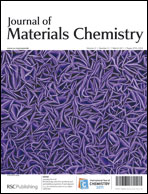The metal–organic frameworks CuTATB-n (TATB = 4,4′,4″-s-triazine-2,4,6-triyltribenzoate; n = power level) having either catenated (CuTATB-60) or non-catenated (CuTATB-30) structure were synthesized in 1 h via a novel sonochemical route. The control of catenation was achieved by simple adjustment of the ultrasonic power levels. The X-ray diffraction patterns, BET surface areas (3778 and 2477 m2 g−1, respectively) and pore volumes, and TGA patterns of the individual product obtained were in agreement with the published literature data of the corresponding materials known as PCN-6 (catenated) and PCN-6′ (non-catenated). Catenation of the two identical networks within large pores resulted in both high surface area and enhanced stability of the network. Such control of catenation was additionally demonstrated by successful synthesis of IRMOF-9 (catenated) and IRMOF-10 (non-catenated) pair by the same sonochemical method. CO2 adsorption properties of the CuTATB-n were measured at 273 and 298 K, which indicated the contribution of catenation in CuTATB-n for CO2 capture. The adsorption isotherms for CO2 and N2 show high adsorption capacity for CO2 (189 mg g−1 and 156 mg g−1, respectively for CuTATB-60 and -30 at 298 K) and excellent selectivity over N2 (>20 : 1). Five consecutive adsorption–desorption runs performed using high purity CO2 in a flow system established no deterioration in the adsorption capacity of CuTATB-60, which showed reversible adsorbent regeneration at 75 °C under He flow and excellent stability for a total duration of 800 min. CuTATB-60 has also demonstrated high gas adsorption capacity (1171 mgCO2 g−1adsorbent) at 30 bar and 298 K.

You have access to this article
 Please wait while we load your content...
Something went wrong. Try again?
Please wait while we load your content...
Something went wrong. Try again?


 Please wait while we load your content...
Please wait while we load your content...